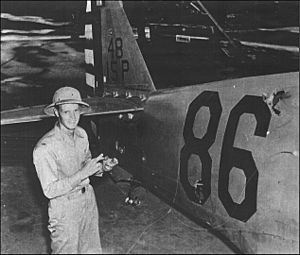Phil Rasmussen facts for kids
Quick facts for kids
Philip M. Rasmussen
|
|
|---|---|

Rasmussen beside damaged P-36 Hawk
|
|
| Born | May 11, 1918 Boston, Massachusetts, US |
| Died | April 30, 2005 (aged 86) Fort Myers, Florida, US |
| Buried | |
| Allegiance | |
| Service/ |
|
| Years of service | 1940–1965 |
| Rank | |
| Unit | 46th Pursuit Squadron |
| Battles/wars | World War II |
| Awards | Silver Star with one oak leaf cluster Distinguished Flying Cross Airman's Medal with three oak leaf clusters |
Philip M. Rasmussen (born May 11, 1918 – died April 30, 2005) was an American pilot. He was a second lieutenant in the United States Army Air Forces. He was stationed at Wheeler Field in Oahu, Hawaii.
On December 7, 1941, he was one of the few American pilots who managed to fly during the Japanese attack. He was given a Silver Star medal for his brave actions that day. He flew many more missions during World War II. After the war, he stayed in the military. He retired from the United States Air Force in 1965 as a lieutenant colonel. He passed away in 2005 and is buried in Arlington National Cemetery.
Contents
Philip Rasmussen's Bravery at Pearl Harbor
On the morning of December 7, 1941, Lieutenant Rasmussen was in his barracks. He looked out the window and saw Japanese planes dropping bombs on the airfield. He quickly grabbed his .45 caliber pistol. He strapped it to his purple pajamas and ran to find an airplane.
Most of the planes were destroyed. But Lieutenant Rasmussen found a P-36 Hawk that was still in good condition. He moved it to a safe spot where it could be loaded with ammunition. When the bombing stopped for a moment, he took off with three other pilots. They were told by radio to fly to Kaneohe Bay.
Fighting Japanese Planes
The American pilots soon faced 11 Japanese aircraft. Lieutenant Rasmussen's plane had problems. His smaller gun was jammed, and his main gun only worked sometimes. Even with these issues, he managed to shoot down a Mitsubishi A6M Zero plane. Several other Japanese pilots then attacked him. One pilot even tried to crash into his plane!
Rasmussen's plane was badly damaged. It went into a fast, uncontrolled dive through the clouds. When he came out of the clouds at about 5,000 feet, he managed to get control of the plane again. He flew back to Wheeler Field. He landed his plane even though it had no brakes, rudder, or tailwheel. People later said his plane had about 500 bullet holes!
The "Pajama Pilot" Exhibit
The story of Lieutenant Rasmussen's actions is famous. The National Museum of the United States Air Force has an exhibit about him. It shows a dummy of a pilot in pajamas climbing into a P-36 Hawk. This exhibit is often called "The Pajama Pilot."
Later Years and Retirement
After his heroic actions, Rasmussen continued his service in the military. He worked in different places around the world. Lieutenant Colonel Rasmussen retired in 1965. He then moved to Florida, where he lived until he passed away in 2005. He is buried at Arlington National Cemetery.
Images for kids
-
In New Guinea with P-400 Airacobra-Ia of 7th Fighter Command (Rasmussen on wing; others unidentified)




